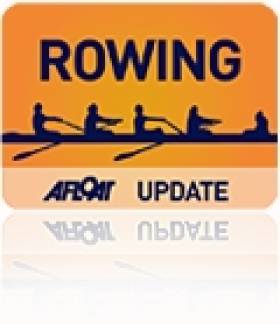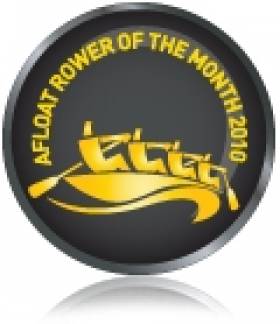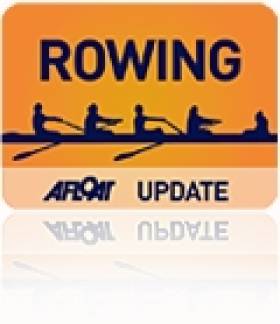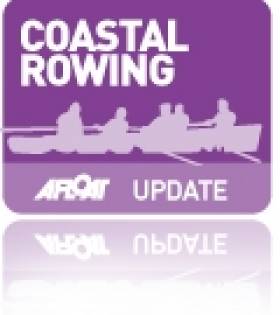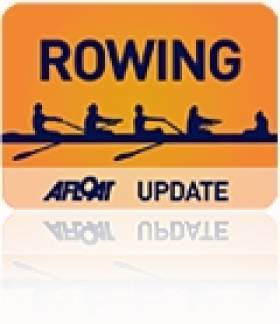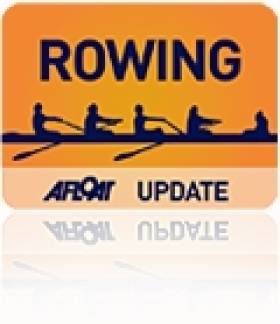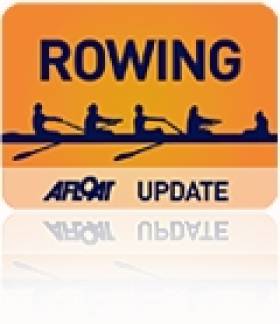Displaying items by tag: rowing
Clavin and Maher Climb to Top of Ladder
Sheila Clavin of St Michael's Rowing Club in Limerick and Michael Maher of Dublin club Commercial came out on top at the 12th Annual Sculling Challenge in Belfast at the weekend. The challenge pits competitors from the Dublin, Cork and Limerick sculling ladders against representatives of the Belfast sculling league.
Annual Sculling Challenge, Belfast, Saturday: Men – Heat One: 1 M Maher (Commercial, Dublin Sculling Ladder), 2 E Marron (Lady Victoria, Belfast Sculling League), 4l. Heat Two: 1 A Hurley (Bantry, Cork SL) row over. Final: 1 Maher, 2 Hurley, 5l
Women – Heat One: 1 S Clavin (St Michael’s, Limerick Sculling Ladder), 2 R Beringer (Belfast RC, Belfast Sculling League), 3l. Heat Two: 1 B Quinn (Commercial, Dublin SL), 2 M Piggott (Bantry, Cork SL) 1 ¼ l. B Final: 1 Beringer, 2 Piggott, easily. A Final: 1 Clavin, 2 Quinn, 4l.
Click this link for Irish Rowing detailsClick this link for the Latest Rowing News
Memorable Month for University Eight
The Afloat Rowers of the Month for August are the Ireland eight which took a bronze medal at the World University Championships in Szeged in Hungary. The crew was assembled from the Queen’s University eight which won the Irish and British university championships, with the co-option of Finbar Manning and David Neale of University College, Dublin.
The crew was: David Neale, Jonathan Mitchell, Eoin Mac Domhnaill, Colin Williamson, Finbar Manning, Abdulrahman Mohamed, Marc Butler, James Graham and cox Andrew Tubman. The coach was Mark Fangen-Hall of Queen’s University.
Rower of the Month awards: The judging panel is made up of Liam Gorman, rowing correspondent of The Irish Times, President of Rowing Ireland Anthony Dooley and David O'Brien, Editor of Afloat magazine. Monthly awards for achievements during the year will appear on afloat.ie and the overall national award will be presented to the person or crew who, in the judges' opinion, achieved the most notable results in, or made the most significant contribution to rowing during 2010. Keep a monthly eye on progress and watch our 2010 champions list grow.
Listen to an extensive interview with the coach of the Ireland crew, Mark Fangen-Hall below
Coakley battles it out with Lynch to win Single Sculls
With the sculling championships coming up in September, there was great interest in the Division 1 and 2 competitions at the Limerick Regatta over the weekend with Skibbereen competing well to hold their Grand League top table position.
In Division 1 of the men's race, with 20 scullers declared, Sam Lynch of St Michael's, Limerick pipped Richard Coakley of Skibbereen in the heats by 0.48 seconds . The two former lightweight internationals battled it out in the final with Coakley exacting revenge in fine style putting Lynch into third spot with Cian Pidgeon, an intermediate from Castleconnell, putting in a fine performance to clinch second place.
In the men's Division 1 4x- race Skibbereen again showed the strength of their junior squad as they beat their club seniors and St Michael's seniors into second and third spot respectively. St Michael's took the Division 1 pairs from the aspiring intermediates from Cappoquin Rowing Club.
The double sculls competition was also keenly contested with several strong Skibbereen doubles in the heats but is was their juniors, fresh back from their silver medal at the European Junior Championships, who took first ahead of their club seniors with Clonmel and St Michaels taking second and third spot.
The Division 2 men's single sculls race, with 34 boats, was made up of novice, junior B and Junior 16 scullers. After the time trials it came down to the top four in Final A which was won by Prenderville from Muckross by 13 seconds from Lee RC, followed by Skibbereen and Workman's, who dead-heated for third place.
The women's Division 1 final was taken by Gillian Hosford of Skibbereen from a young Kate O'Brien from St Michaels. In the Division 2 final Corcoran-O'Hare (Shandon) beat Marie Piggott (Bantry) by a mere 0.43 seconds in a close finish.
In the Junior 14 and 15 ranks there was a massive entry of enthusiastic young rowers with the honours spread fairly widely around the clubs of Galway, Carrick on Shannon, Cork, Carlow, and Athlone. It was good to see new club Colaiste Chairáin from Croom in County Limerick show that, with ambition and hard work, you can get a rowing programme off the ground.
While the regatta entries were mainly Munster based, clubs from all four provinces were represented, reflecting an appetite, despite the traditional holiday season, for a serious August regatta in preparation for the small boat National Championships in September.
Click this link for Irish Rowing detailsClick this link for the Latest Rowing News
Hughes 10th Overall at World Junior Champs
Turlough Hughes finished fourth in the B Final of the men’s single sculls at the World Junior Championships in Racice in the Czech Republic this morning. Portugal’s Tome Perdigao won a battle with Serbia’s Alexsandar Filipovic at the head of the field, while Hughes lost out for third to Lithuania’s Zygimantas Galisanskis. The Irishman’s performance gave him 10th overall at the Championships.
Junior World Championships, Racice, Czech Republic. Day Four (Irish interest)
Men’s Single Scull – B Final (Places 7-12): 1 Portugal (T Perdigao) 7:17.15, 2 Serbia (A Filipovic) 7:19.04, 3 Lithuania (Z Galisanskis) 7:19.13, 4 Ireland (T Hughes) 7:20.51, 5 Croatia 7:21.58, 6 Estonia 7:25.10
Hughes Fifth in World Championship Semi
Turlough Hughes finished fifth in the semi-final of the men’s single scull at the World Junior Championships in Racice, Czech Republic. The race was won by the reigning world champion, Felix Bach of Germany, with Jakub Podrazil of the Czech Republic second. Andrew Campbell of the United States took the third A Final qualification place. Hughes is now destined for tomorrow’s B Final, which determines places seven to 12.
World Junior Championships, Racice, Czech Republic, Day Three (Irish interest)
Men’s Single Scull, Semi-Final Two (First Three to A Final; rest to B Final): 1 Germany (F Bach) 7:42.56, 2 Czech Republic (J Podrazil) 7:46.36, 3 United States (A Campbell) 7:46.78; 4 Estonia (J Laos) 7:54.18, 5 Ireland (T Hughes) 7:57.90, 6 Croatia (B Gardijan) 8:12.01.
Click this link for Irish Rowing detailsClick this link for the Latest Rowing News
Hughes Finishes Well to Make Semi-Final
Turlough Hughes improved from fifth to third in the final quarter to secure a place in the semi-finals of the World Junior Championships at Racice in the Czech Republic this morning. Andre Redr of Slovakia was the clear winner, with Estonia’s Joosep Laos second.
World Junior Championships, Racice, Czech Republic, Day Two (Irish interest)
Men’s Single Scull – Quarter-Final Two (First Three to A/B Semi-Final; rest to C/D Semi-Finals): 1 Slovakia (A Redr) 7:19.24, 2 Estonia (J Laos) 7:20.85, 3 Ireland (T Hughes) 7:21.87; 4 Albania 7:22.41, 5 Hungary 7:23.35; Georgia did not finish.
Click this link for Irish Rowing detailsClick this link for the Latest Rowing News
Galway's Atlantic Oarsman in World Record
At the beginning of August, a 23ft four-man rowing boat arrived off The Lizard, England's most southerly headland and the traditional point for Transatlantic bids, to establish a new transoceanic rowing time for the crew of one Irishman, two Scotsmen, and a Faroes islander. Lorna Siggins of The Irish Times set the scene as they made their first landfall approaching the Isles of Scilly fifty miles westward. Click HERE.
Click this link for Irish Rowing detailsClick this link for the Latest Rowing News
Hughes Clears First Hurdle at World Champs
Turlough Hughes made it through the first test at the World Junior Championships in Racice in the Czech Republic today. The 18-year-old took third place in his heat and qualified for tomorrow’s quarter-finals. Felix Bach of Germany, the defending champion, won the race by a margin of almost 10 seconds.
World Junior Championships, Racice, Czech Republic. Day One (Irish interest)
Single Scull – Heat Three (First Four to Quarter-Finals; rest to repechage): 1 Germany (F Bach) 7:26.63, 2 Lithuania (Z Galisanskis) 7:36.61, 3 Ireland (T Hughes) 7:40.60, 4 South Africa (M Mahomed) 7:46.79; 5 Switzerland 7:46.58.
Click this link for Irish Rowing detailsClick this link for the Latest Rowing News
Hughes Faces Champion at World Juniors
Ireland’s sole representative at the World Junior Championships, Turlough Hughes, has drawn the defending champion, Felix Bach of Germany, in his heat of the single scull. Four of the five scullers in the heat tomorrow will make it to the quarter-finals.
Click this link for Irish Rowing detailsClick this link for the Latest Rowing News
Two More Silver Medals for Ireland Juniors
Shane O’Driscoll and Paul O’Donovan added a second silver rowing medal to their collection on the final day of the Coupe de la Jeunesse in Hazewinkel in Belgium on Sunday. In a repeat of Saturday’s results, the Ireland junior double scull were again very close to gold-medal winners Hungary – this time just .3 of a second behind.
Ireland’s junior women’s quadruple also took silver. Denise Walsh, Holly Nixon, Christine Fitzgerald and Shelly Dineen finished a close-up second to Italy. The Ireland junior men’s pair of Rodrigo Prodohl and Simon Hewitt won their B Final and the junior men’s quadruple were fourth in their B Final (10th overall).
Coupe de la Jeunesse, Hazewinkel, Belgium. (Irish interest)
Saturday
Junior Men,
Pair – B Final (Places 7-12): 4 Ireland (S Hewitt, R Prodohl) 7:22.38.
Sculling, Quadruple – B Final (Places 7-12): 3 Ireland (M Monteith, D O’Driscoll, A Sheehan, G O’Donovan) 6:16.11.
Double - A Final: 1 Hungary 6:38.89, 2 Ireland (S O’Driscoll, P O’Donovan) 6:40.08, 3 Netherlands 6:42.43.
Junior Women
Sculling, Quadruple – A Final: 1 Italy 6:47.28, 4 Ireland (D Walsh, C Fitzgerald, S Dineen, H Nixon) 6:55.23.
Sunday
Junior Men,
Pair - B Final (Places 7-12): 1 Ireland 7:17.09.
Sculling, Quadruple – B Final (Places 7-12): 4 Ireland 6:20.75
Double – A Final: 1 Hungary 6:40.37, 2 Ireland (O’Driscoll, O’Donovan) 6:40.67, 3 Britain 6:41.09.
Junior Women,
Sculling, Quadruple – A Final: 1 Italy 6:48.25, 2 Ireland (Walsh, Fitzgerald, Dineen, Nixon) 6:49.43, 3 Britain 6:50.67.
Click this link for Irish Rowing detailsClick this link for the Latest Rowing News



























